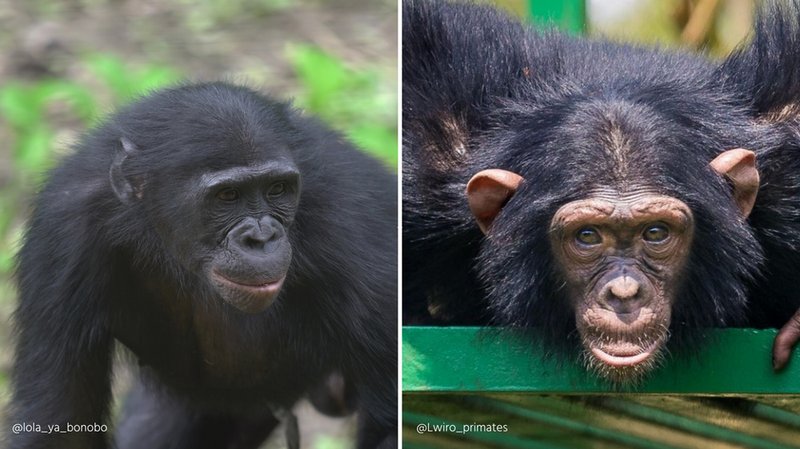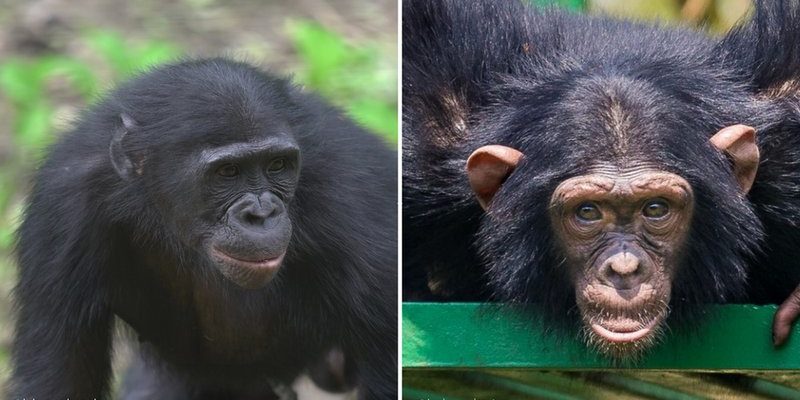
In this article, we’ll explore 10 animals similar to the bonobo and give you tips on how to tell them apart. It’s like going on a little safari from the comfort of your couch. Whether you’re a wildlife lover or just looking to impress friends at your next trivia night, understanding these remarkable creatures is a fun journey. So, grab your favorite drink, and let’s dive in!
1. Chimpanzee
The chimpanzee is probably the closest relative to the bonobo. Both of these primates belong to the same genus, *Pan*, and share around 98.7% of their DNA with humans. Just imagine them as two cousins who took different paths in life.
Differences in Behavior
While bonobos are known for their peaceful and matriarchal societies, chimpanzees often display more aggressive behaviors. Chimpanzees hunt in groups and can be quite territorial. This difference in social structure is fascinating. Bonobos resolve conflicts through social bonding, while chimpanzees might resort to aggression, showcasing a more competitive nature.
Physical Traits
Visually, chimpanzees tend to be larger and more muscular than bonobos. Chimpanzees have more pronounced facial features, including a broader nose and larger ears. You might notice that bonobos generally have a more slender frame and a flatter face. This is a great way to tell them apart when you see them in documentaries or at a zoo.
2. Gorilla
Gorillas are another fascinating primate that shares a family with bonobos. They are known for their immense size and strength. Picture a gentle giant, though, as gorillas are mostly herbivorous and have a calm demeanor.
Differences in Size and Diet
While bonobos are relatively small, gorillas can weigh up to 400 pounds! This size difference is striking. Also, gorillas primarily eat leaves, stems, and fruit, setting them apart from the omnivorous diet of bonobos, which can include insects as well.
Social Structures
Gorillas live in groups led by a dominant male, called a silverback. In contrast, bonobos display a more egalitarian society. It’s interesting to see how social hierarchies differ between these primates, reflecting their distinct traits and behaviors.
3. Orangutan
Orangutans are the lone wolves of the primate world, known for their incredible intelligence and solitary lifestyle. Unlike bonobos, who thrive in groups, orangutans prefer to spend much of their time alone.
Differences in Habitat
You’ll primarily find orangutans in the rainforests of Borneo and Sumatra, whereas bonobos call the forests of the Congo home. Their habitats play a significant role in shaping their behaviors and social structures.
Physical Traits
Orangutans are distinguished by their long arms and reddish-brown fur. While bonobos have dark hair and a more compact build, these unique physical traits can help you tell them apart. Just think of them as the introverted relatives of the bonobo family!
4. Macaque
Macaques are fascinating as they display a wide range of social structures and habitats. They can adapt to various environments, from snowy mountains to urban areas.
Differences in Social Behavior
Macaques are often more aggressive than bonobos and are known to engage in complex social hierarchies. For instance, they can be quite territorial, whereas bonobos are more about sharing and social interaction.
Physical Traits
You’ll notice that macaques have a more varied appearance than bonobos. They come in different colors and sizes depending on the species. While bonobos have a uniform look, macaques can be quite diverse, which can make identifying them an interesting challenge!
5. Capuchin Monkey
Capuchins are often seen in movies and TV shows, known for their intelligence and playful nature. They are small primates that enjoy being in groups, which is somewhat similar to bonobo behavior.
Differences in Size and Intelligence
Capuchin monkeys are much smaller than bonobos and have distinct intelligence. While both species showcase cleverness, capuchins are often used in research for their problem-solving skills. You might find these little guys working together to accomplish tasks, but they don’t have the same level of emotional bonding that bonobos do.
Distinctive Features
With their characteristic “cap” of fur on their heads, capuchins are easy to identify. They also have expressive faces that show a wide range of emotions. This makes them quite charming, but they are distinctly different from the more serious-looking bonobos.
6. Tamarin
Tamarins are tiny monkeys bursting with personality and energy. These little guys are social animals, living in groups much like bonobos do, but they have unique traits that set them apart.
Differences in Size and Habitat
Tamarins are much smaller than bonobos, weighing only about a pound or so. They live primarily in the forests of South America, far from their bonobo cousins in Africa.
Social Structures
While tamarins live in groups, their social behavior tends to be less complex than that of bonobos. They often form family units rather than the large social networks bonobos maintain. Think of tamarins as the extroverted cousins who always bring the party!
7. Gibbon
Gibbons are known as the “lesser apes,” but don’t let that title fool you. They might be smaller than bonobos, but they’re incredibly agile and social creatures.
Differences in Movement
One of the most noticeable differences is how gibbons move through the trees. They are experts at brachiation—swinging from branch to branch—which is quite different from the moderate climbing style of bonobos.
Social Behavior
Gibbons typically mate for life and are known for their monogamous relationships. In contrast, bonobos are more fluid in their mating habits. This difference highlights the various ways primates can socialize and form bonds, making the animal kingdom quite fascinating.
8. Squirrel Monkey
Squirrel monkeys are small, nimble, and incredibly curious little primates. They have a playful demeanor and are known for their social nature.
Differences in Size and Social Structure
Squirrel monkeys are smaller than bonobos and have a distinctively different body structure. While bonobos can weigh up to about 100 pounds, squirrel monkeys typically max out around 20 pounds. This size difference is pretty striking!
Diet and Behavior
Squirrel monkeys mainly eat fruit, insects, and small animals. Their foraging behavior is different from the more varied diet of bonobos. They often move in troops through the treetops, though their social interactions can be more competitive than those of bonobos, who are more collaborative.
9. Aye-Aye
The aye-aye is a unique primate found in Madagascar, and it certainly stands out! With its large eyes and elongated fingers, it has a quirky appearance that’s unlike any of the other animals on this list.
Differences in Habitat
Aye-ayes live in a totally different part of the world compared to bonobos. While bonobos inhabit the African rainforests, aye-ayes roam the forests of Madagascar.
Feeding Habits
Aye-ayes have a fascinating feeding technique where they tap on wood to locate insects, something bonobos don’t do. This unique adaptation sets them apart from the more fruit and plant-based diet of bonobos and emphasizes the diversity in the animal kingdom.
10. Tarsier
Tarsiers are adorable little primates famous for their enormous eyes and unique nocturnal behavior. They are small and agile, making them a delight to observe.
Differences in Size and Behavior
Tarsiers are much smaller than bonobos, with their tiny bodies measuring just about 4 to 6 inches long. They rely on their acute night vision to hunt for insects during the dark hours. This nighttime lifestyle sets them apart from bonobos, who are primarily active during the day.
Social Structures
While tarsiers do engage in social behavior, they are more solitary than bonobos. You won’t see them forming large groups; instead, they tend to maintain smaller family units. This difference in social interaction is an example of how diverse primate behavior can be.
In summary, while the bonobo holds a special place in the primate family tree, it’s clear there’s a vibrant world of other animals that share similarities. From the playful chimpanzee to the quirky aye-aye, each species offers a unique glimpse into the diverse behaviors and traits found in the animal kingdom. By understanding these differences, we can appreciate the rich tapestry of life around us even more! So next time you think of bonobos, remember the intriguing relatives that share the family tree with them.

